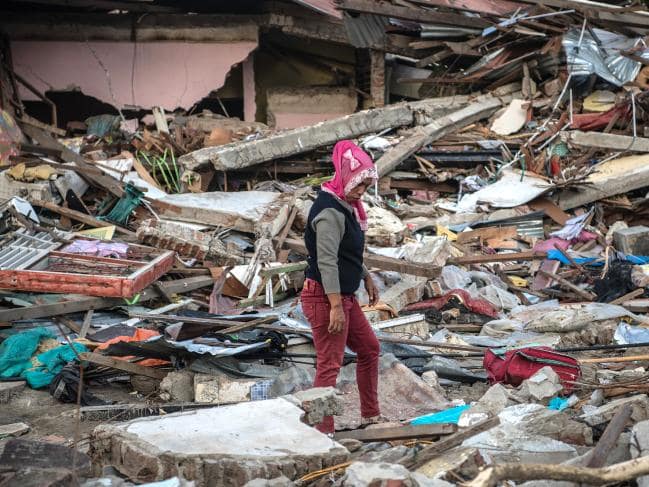
This article is more than
8 year old
WARNING: Graphic content may affect some readers.
Bright-coloured body bags are being placed side-by-side in a freshly dug mass grave as a hard-hit Indonesian city began burying its dead from the devastating earthquake and tsunami that killed more than 840 people and left thousands homeless.
Desperate survivors have been looting shops and petrol stations in the aftermath of the disaster.

The death toll, largely from the city of Palu, is expected to keep rising as areas cut off by the damage are reached. The magnitude 7.5 earthquake struck at dusk on Friday and generated a tsunami said to have been as high as 6 metres in places.

The UN’s relief agency believes that 191,000 people are in urgent need of humanitarian assistance in the quake and tsunami-battered region of Sulawesi.
The United Nations Office for the Coordination of Humanitarian Affairs said the figure included around 46,000 children and 14,000 elderly Indonesians, many beyond urban areas that are the focus of government recovery efforts.
Local army commander Tiopan Aritonang said 545 bodies would be brought to the grave from one hospital alone. The trench dug in Palu was 10 metres 100 metres and can be enlarged if needed, said Willem Rampangilei, chief of Indonesia’s National Disaster Mitigation Agency. “This must be done as soon as possible for health and religious reasons,” he said. Indonesia is majority Muslim, and religious custom calls for burials soon after death, typically within one day.

Local military spokesman Mohammad Thorir said the area adjacent to a public cemetery can hold 1,000 bodies. All of the victims, coming from local hospitals, have been photographed to help families locate where their relatives were buried. Video footage showed residents walking from body bag to body bag, opening the tops to check if they could identify faces.
Military and commercial aircraft were delivering some aid and supplies. But there was a need for heavy equipment to reach possible survivors buried in collapsed buildings, including an eight-story hotel in Palu where voices had been heard in the rubble.
ANGER GROWS AS LOCALS RUN OUT OF FOOD
People suffering from a lack of food and supplies were also becoming more desperate. Local television said around 3,000 residents had flocked to the Palu airport trying to get out. Footage showed some people screaming in anger because they were not able to board departing military aircraft. The airport has resumed only some commercial flights.
“We have not eaten for three days!” one woman yelled. “We just want to be safe!” Indonesian President Joko “Jokowi” Widodo authorsed the acceptance of international help, said disaster agency spokesman Sutopo Purwo Nugroho, adding that generators, heavy equipment and tents were among the items needed. He said the European Union and 10 countries have offered assistance, including the United States, Australia and China.

Prime Minister Scott Morrison says the Australian government is standing ready to provide assistance if it’s requested but Indonesia has yet to ask.
“This is a terrible tragedy,” Mr Morrison said on Monday.
“Australia stands ready to assist as is needed. But I think it’s important that all of our empathy and thoughts are with them in what must be a most horrific time for them.
“The Foreign Minister is working closely with other counterparts in Indonesia to correspond with any assistance which is necessary.”
FEARS HUNDREDS BURIED IN MUD
Mr Nugroho said conditions in the Balaroa area of Palu were particularly bad because the earthquake caused the ground to violently heave up and sink down in places, trapping many people under destroyed houses. In Petobo, another area of the city, the temblor caused liquefaction, when loose, water-filled soil near the surface loses its strength, causing massive damage.

“In Petobo, it is estimated that there are still hundreds of victims buried in mud material,” he said.
Villagers who pulled out loved ones - alive and dead - over the weekend expressed frustration that it took rescue teams until Monday to reach Petobo. Edi Setiawan, 32, said he and fellow villagers were able to rescue five children and four adults, including a pregnant woman. However, his sister and father were not among them.

“My sister was found embracing her father,” he said. “My mother was able to survive after struggling against the mud and being rescued by villagers.” Another villager, 52-year-old Idrus, who uses one name, said that “up to Saturday we still saw many people screaming for help from the roofs. But we could not do anything to help them. Now their cries are no longer heard.” But there were cases of survivors still being pulled from the rubble in different locations, including a 25-year-old woman found alive Sunday evening in the ruins of the Roa-Roa Hotel, according to the National Search and Rescue Agency, which released photos of her lying on a stretcher covered with a blanket.
CONCERNS DEATH TOLL WILL RISE
The confirmed death toll of 844 released by Nugroho on Monday afternoon was an increase of only 12 since the previous day, with nearly all of the total from Palu. The regencies of Donggala, Sigi and Parigi Moutong — with a combined population of 1.2 million — had yet to be fully assessed. Nearly 50,000 people have been displaced from their homes in Palu alone, Nugroho said. He said 114 foreigners were in Palu and Donggala during the disaster.

All were accounted for except one Belgian, one South Korean and six French. It was the latest natural disaster to hit Indonesia, which is frequently struck by earthquakes, volcanic eruptions and tsunamis because of its location on the “Ring of Fire,” an arc of volcanoes and fault lines in the Pacific Basin. In December 2004, a massive magnitude 9.1 earthquake off Sumatra island in western Indonesia triggered a tsunami that killed 230,000 people in a dozen countries. More recently, a powerful quake on the island of Lombok killed 505 people in August.

In Donggala, the site closest to the earthquake’s epicentre, aerial footage on Metro TV showed the sugary blond sands of beaches swept out to sea, along with some buildings. Some buildings in the town were severely damaged, with plywood walls shredded and chunks of concrete scattered on the pavement. Much of the damage, however, appeared limited to the waterfront.
Palu, which has more than 380,000 people, was strewn with debris from the earthquake and tsunami. A heavily damaged mosque was half submerged and a shopping mall was reduced to a crumpled hulk. A large bridge with yellow arches collapsed.
The city is built around a narrow bay that apparently magnified the force of the tsunami as the waves raced into the tight inlet. Nugroho said waves were reported as high as 6 meters (20 feet) in some places.
In one devastated area in Palu, residents said dozens of people could still be buried in their homes.
“The ground rose up like a spine and suddenly fell. Many people were trapped and buried under collapsed houses. I could do nothing to help,” resident Nur Indah said, crying. “In the evening, some of them turned on their cellphones just to give a sign that they were there. But the lights were off later and the next day.”